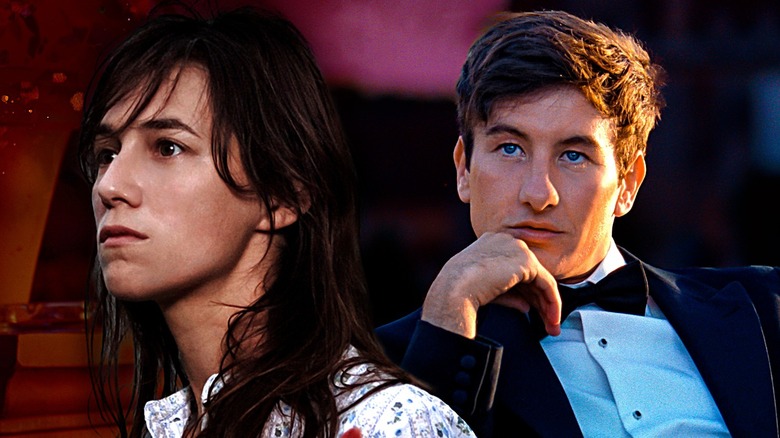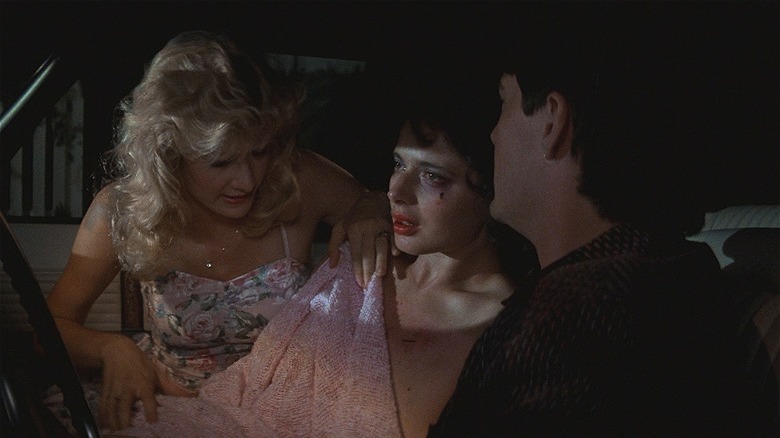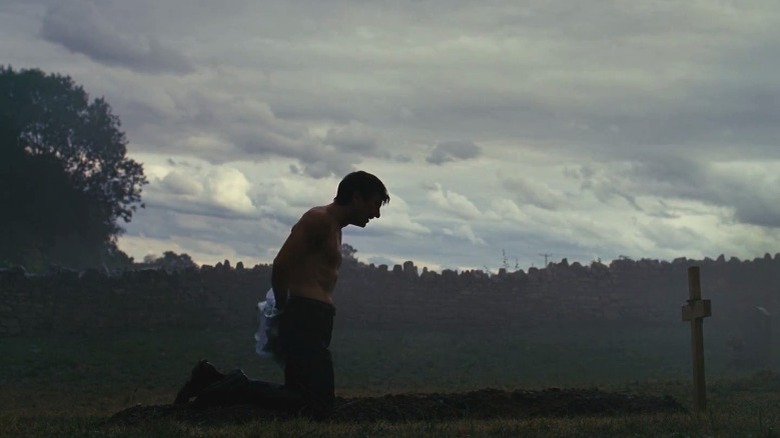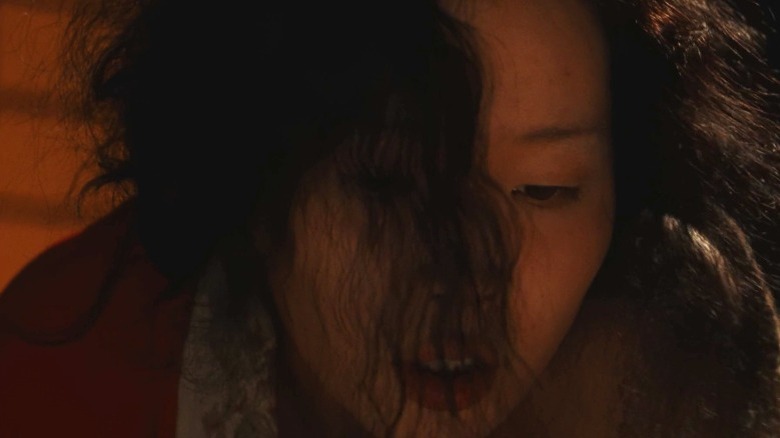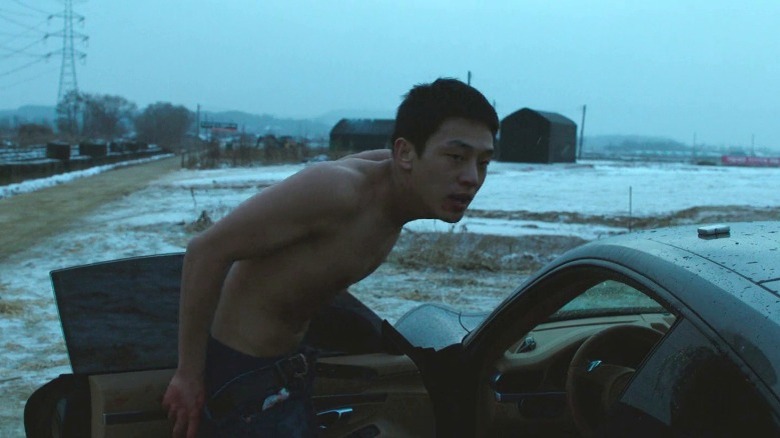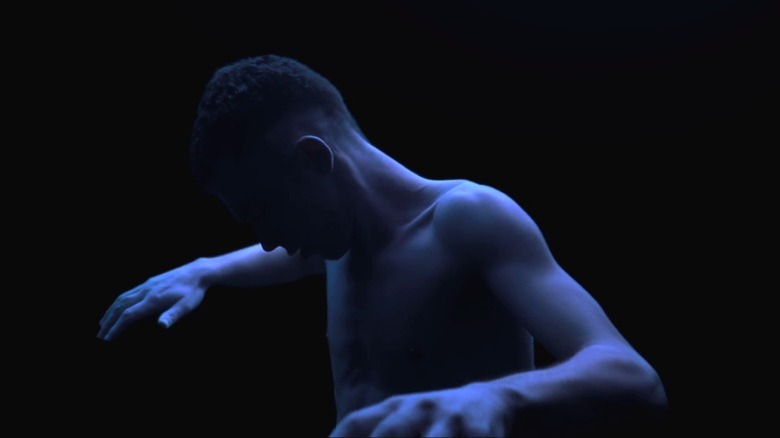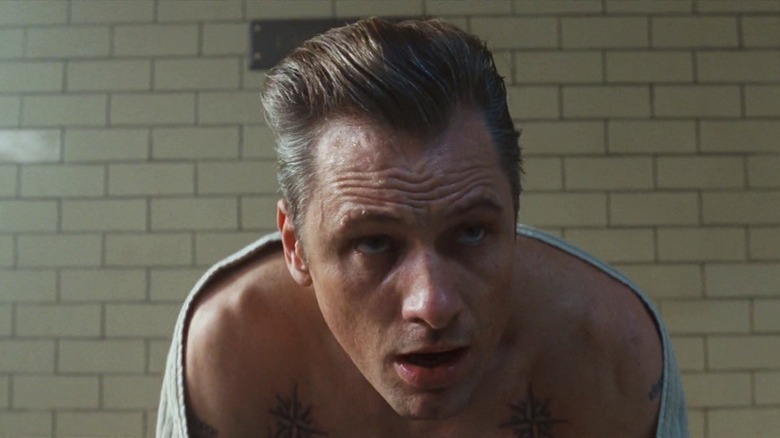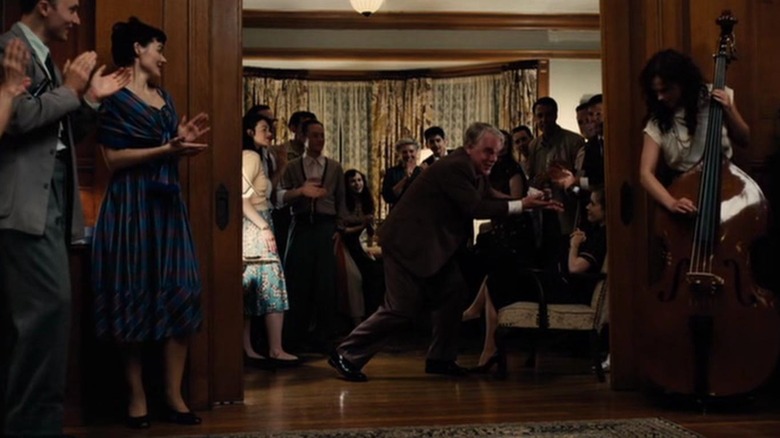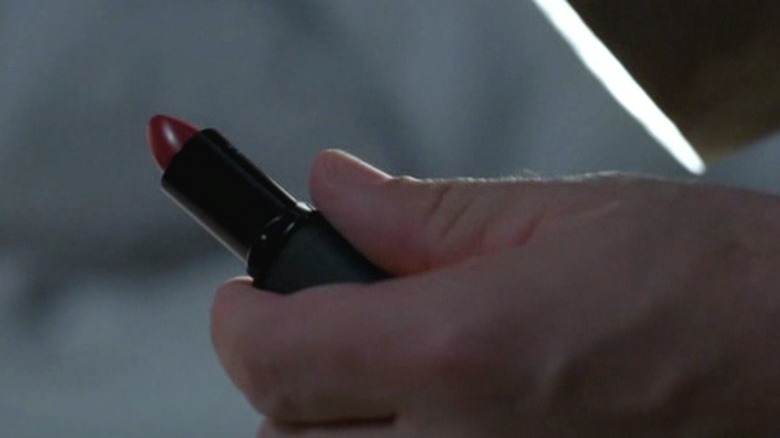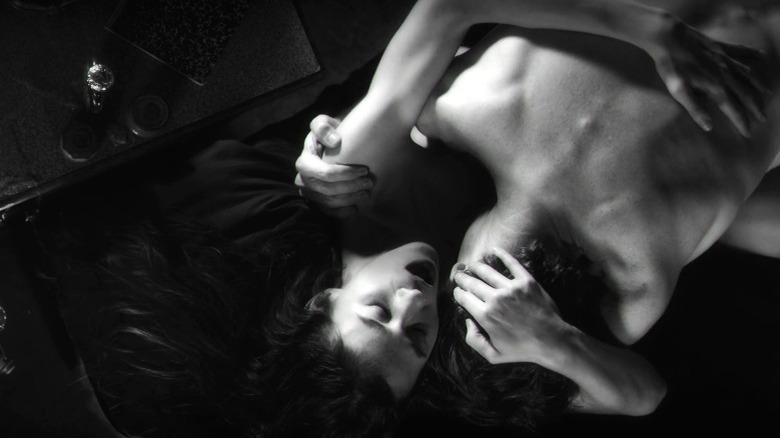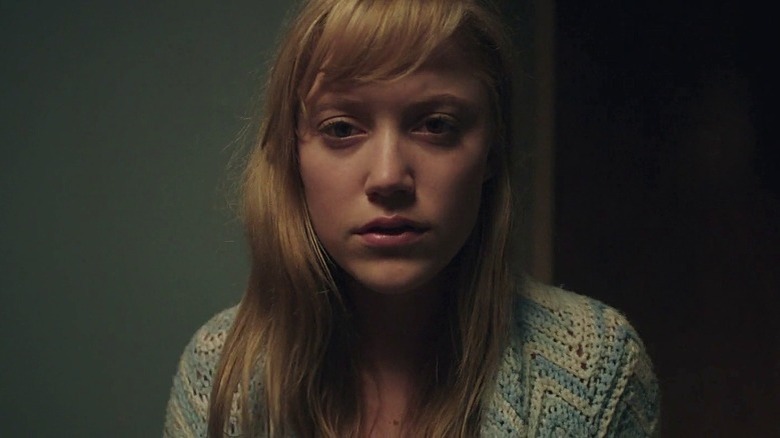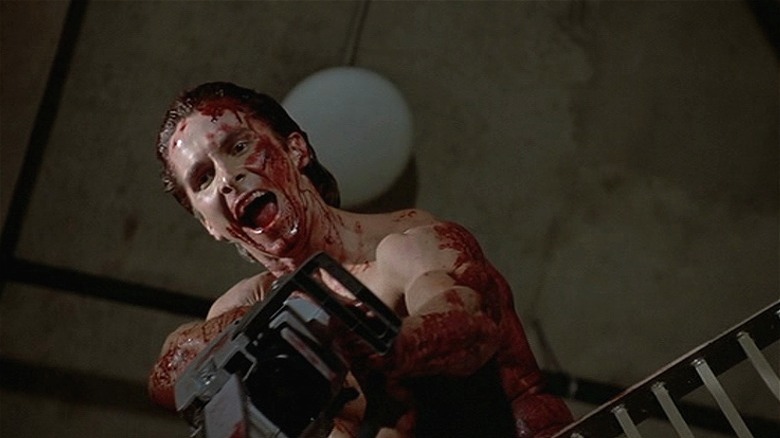The Most Disturbing Nude Scenes Ever Filmed
Contrary to what some cultural commentators would have you believe, nudity in cinema goes back as far as the 19th century when the first cinematograph operators immediately saw the medium's potential to bring voyeurism to new heights and began producing skin flicks. In other words, it's fair to say that onscreen nudity is just about as old hat as real-life nudity — at the end of the day, it's just bodies; everybody's got 'em.
Still, there's something about a good use of nudity that can rip through the fabric of a film and make the viewer reconsider all they've been seeing. A shrewd depiction of bare bodies can engage our deepest-seated anxieties about the frailty of our flesh frames, challenge our unconscious puritan biases and hang-ups, or yank us into levels of grit and realism once presumed inaccessible by commercial cinema's tacit rules of modesty. Great directors around the world have spent decades thinking up ways to wield audiences' arbitrary discomfort with nudity against them, challenge them on their desire for nudity-as-objectification, or do both at the same time.
While by no means exhaustive, this list collects several instances of film scenes that utilize male or female nudity to particularly shocking, skin-crawling, or otherwise disturbing effect, along with explanations for why those scenes make such an impact. From pervy fantasies to blood-streaked saunas to violated graves, here is the body at its most abrasive.
Blue Velvet: Dorothy arrives at the house
Strange, innocence-shattering combinations of fascination and terror have turned up in many of David Lynch's psychosexual tableaux over the years, and "Blue Velvet" stands out as the clearest, most enlightening, most generative example of that thematic obsession. The 1986 film, with its tale of idealized American purity battling it out with sexual compulsion and violence, effectively served as a microcosm of both its director's incipient cosmovision and the larger cultural maelstrom of Reagan's America. In one particular scene near the film's end, both those themes reach their apex via a shocking use of nudity.
Up until this point, Jeffrey Beaumont (Kyle MacLachlan) has been hiding his sexual trysts with Dorothy Vallens (Isabella Rossellini), as well as his attending brush with the Lumberton criminal underworld, from his friends and family. Suddenly, a fully nude Dorothy turns up at his cozy suburban home, dazed, beaten, and bloodied, bringing the banal plot of Jeffrey and Sandy Williams (Laura Dern) versus Sandy's jealous ex (Ken Stovitz) to a screeching halt as everyone scrambles to deal with the bruised stranger. Just like that, the world seems bigger, scarier, and racier than every character but Jeffrey believed it to be; his shadow life intrudes on his "normal" life with the brute force of a dream taking over reality — or vice-versa. There's an argument to be made that "Blue Velvet" is a fundamentally conservative film, but it certainly understands and honors the intoxicating power of the forbidden.
Saltburn: Grave scene
Emerald Fennell's "Saltburn" may not exactly be a New French Extremity-level freakout, but between all the drain-licking, hand-spitting, and menstrual cunnilingus, it's certainly one of the most outrageous and sexually adventurous mainstream films to come out in years. Even so, one scene easily takes the cake as its most shocking.
Fennell, who knows we won't be expecting what's coming, takes her sweet time building towards the money shot. At first, it seems like Oliver (Barry Keoghan) will merely engage in a very open and full-bodied display of grief, crying hysterically and hugging the earth as though some delayed form of remorse has finally hit him. Then, he gets back on his knees and takes his shirt off – huh, weird. And then it happens: Keoghan unzips, whips it out, and, though we only get a very brief glimpse at his penis before he shoves it into the grave, it's enough for a full-body jolt. He's really doing it.
It's clear from the film's first minutes that there's something off about Oliver, but nothing in the film prepares you for grave desecration, and Fennell smartly times her subtlest yet most unexpected use of nudity to coincide with that sudden swerve into darker territory. The result is a scene both shocking in the moment and very difficult to parse: Is Oliver a necrophile? Did he actually love Felix (Jacob Elordi)? Is he engaging in another display of power? Is he just really horny and messed up? Too many questions; no answers; lingering shudders.
In the Realm of the Senses: Castration
At the end of the 1976 Japanese classic "In the Realm of the Senses," Sada Abe (Eiko Matsuda) erotically asphyxiates Kichizō Ishida (Tatsuya Fuji) to death, and then castrates him in order to carry his penis inside her wherever she goes. If that sounds disturbing, wait until you see how director Nagisa Ōshima shot it.
There are many components to the scene's singular, unshakable, medium-shattering power. True to his penchant for tasteful ornamentation, Ōshima surrounds the moment of the castration itself with immaculately rendered, albeit morbid, mutual pleasure — shots upon shots of Sada and Ishida inching towards a relaxed bliss, the bliss of lovers who have truly fallen into the abyss of each other. Even as she strangles him, there's a sense of every image and every movement being just right, irresistible in their cumulative gorgeousness.
And then she simply takes the knife and does it, in close-up, her hands calm but her face possessed, like it's not unwatchably revolting. The process is slow, and Ōshima depicts it as such, never flinching, not even from his own established rule of beauty. It's another masterfully composed shot, as clear and simple as it is to describe: She cuts off his penis. Were it not the work of an artist so savvy and intelligent, you'd think the film sees nothing out of the ordinary about what Sada is doing. But of course, it's all very deliberate — the most indelible possible version of a scene that would be indelible regardless.
Burning: Final scene
Lee Chang-dong's "Burning" is a pressure cooker kept at a simmer for nearly the entire runtime, only to burst gruesomely and messily in the very final moments. Following months of uncertainty, Jong-su (Yoo Ah-in) has finally convinced himself that Ben (Steven Yeun) has, indeed, killed Hae-mi (Jeon Jong-seo). Armed with that self-permission, he summons Ben to a countryside meet-up, stabs him, sets the scene on fire, and leaves.
Naturally, in a scene with murder and arson, nudity is small potatoes. But it's the little details that separate a great filmmaker like Lee from the rest. If the ending of "Burning" is a release of pent-up tension so sudden, curt, and anti-climatic that it only begets more queasiness, Jong-su's haphazard behavior — allowing himself nary a moment to breathe as he scrambles to get it over with and bounce — is what sells it. And, in that sense, seeing Jong-su desperately rid himself of every piece of clothing, toss it all into the car, and stumble away in the freezing cold is the stinger that makes the denouement so haunting.
It feels like watching Jong-su be reduced in real-time to a trembling wild animal, driven only by survival instinct — almost as though he takes refuge in beastliness to finally sublimate himself away from his myriad human paranoias. There's nothing sensational or sexual about it; it's just a blunt cap on an explosion of raw violence. Nothing ends; nothing is resolved; there is nothing left but the body.
Under the Skin: Second seduction
"Under the Skin" is a disturbing movie from top to bottom, but every scene in which the Female (Scarlett Johansson) lures men into the fluid-draining alien trap packs a special wallop. Each of those sequences is a mini-masterpiece in horror, with various disparate elements brought into a harmonious crescendo of dread. The chamber in itself is creepy as all get out; the slow descent into the dark fluid is both bizarre and nauseating in its slow, inexorable certainty; that the victims enter it of their own volition, slipping into a fugue state of horniness without even noticing it, makes things all the more spine-tingling. But the full, unceremonious nudity is what cinches it: We're watching prey willingly lodge itself in the predator's mouth, going even to the trouble of shedding its protective shell.
On that note, the one iteration that's really impossible to shake off is the second, in which we see the inside of the trap. The entire world has fallen away for these two poor men, and now all that's left for them to experience in their final moments is this state of impotent, vulnerable suspension in a featureless void which engulfs every inch of their skin as if dragging them back into a fetal, pre-worldly state. They desperately reach out to touch hands, longing for some measure of connection before it's all over ... and then that happens to Guy #1 as Guy #2 watches, knowing he'll be next. Rarely has the human body looked so fragile on screen.
Eastern Promises: Sauna fight
Over the course of his career, David Cronenberg has developed a sharp, intuitive understanding of the human body's geography and pressure points. Although the bulk of those years of study happened in the horror genre, his expertise came to serve him handsomely in the 2007 crime drama "Eastern Promises" — specifically in the staging of the film's infamous bathhouse sequence. In it, a naked and unsuspecting Nikolai Luzhin (Viggo Mortenesen) gets ambushed by two fully-clothed Chechen assassins (Tamer Hassan and David Papava).
At first, as the film builds patiently towards the moment of the fight, Mortensen keeps the towel on, and it almost seems like there might not end up being any explicit nudity. Then, Cronenberg springs it all on the viewer — the thuds, the nudity, the roars of pain, the linoleum knives — swiftly and at once. What follows is one of cinema's most brutally unglamorous physical tussles ever, three men desperately clawing at each other in an awry yet single-minded effort to simply come out alive. The camera never lingers on Mortensen's genitals; they're merely there, as yoked to his body as his legs or his bloody back. For Cronenberg, in a moment like that, there's no point in making any secret of this or that body part; at the end of the day, it's all just tissue from which pain can be extracted. Even working wholly outside the horror genre, he goes and does for saunas what "Psycho" did for showers.
The Master: Freddie's fantasy
As a drunken Freddie Quell (Joaquin Phoenix) drifts slowly towards sleep, he is faced with a scene that feels like its own waking dream: Lancaster Dodd (Philip Seymour Hoffman), the man to whom he has elected to tether his whole sense of self, lording over the crowd in the Philadelphia house where their cult has received a hero's welcome. As a boundlessly devoted follower of Dodd, Freddie relishes his leader's ability to flaunt such aspirational charisma, protagonism, female attention; the sea shanty he's bellowing evinces a captain's sense of direction — the very thing Freddie so yearns for in his life. He leans his head peacefully against a pillow. He's at home.
Paul Thomas Anderson's "The Master," of course, is not a film about a man finding home in the arms of a loving religious movement. And so, just as that cozy moment snaps fully into Freddie's view, he falls into a vision — maybe a dream, maybe a fantasy — of unbridled, expressionistic lust. Unlike the highfalutin Dodd, Freddie has no illusions about himself, and sees Dodd's little show for what it really is: an elaborate sexual overture. Every single woman in the house appears naked before his eyes, while Dodd and the other men retain their formal clothes; only Peggy Dodd (Amy Adams), who also sees through it all, turns Freddie's devouring gaze back against him. In the end, this is what the Cause and equivalent movements are all about: Horny men and their delusions of power over whoever or whatever they desire.
Anatomy of Hell: Lipstick scene
Of all the turn-of-the-century French hardcore masters, Catherine Breillat is arguably the one whose sexual provocations have endured as the most genuinely subversive. Each of her films from the late '90s and early 2000s is a profound study of the human psyche shot through with unflagging consciousness of the patriarchy's various disfiguring and depersonalizing horrors. Just the synopsis of her most controversial film, 2004's "Anatomy of Hell," is enough to raise eyebrows: A woman (Amira Casar) pays a gay man (Rocco Siffredi) to embark on a no-holds-barred four-day sexual exploration with her.
It's hard to even single out a scene from the film as the most unsettling; Breillat's whole game in it is to twist nonstop nudity and sexuality into disturbing pretzels. Yet there's a secret to her shocking images: By pushing beyond "acceptable" boundaries in her depiction of female nudity, she demands that the viewers — especially male ones — reflect on the arbitrary rules and gripes that mediate their understanding of women's bodies.
This comes to a head in the scene where the man draws on the woman's nether regions with lipstick, circling her vagina and anus. The man's unexpected, sexually opaque, obliquely domineering behavior forces the viewer into an uncomfortable reckoning with their own position in relation to the onscreen nudity: If your own eyes single out and insulate the woman's genitalia, as though they'd suddenly ceased to be mere features of a person when seen up close, why does it shock you to see the man do the same thing more literally?
Antichrist: Parental neglect
Lars von Trier's "Antichrist" has about as many passionate fans as it has disparagers, but no one can dispute that it's a deeply personal, deeply emotional film. Conceived in the throes of von Trier's struggles with depression, it's a film that allows itself to truly sit and grapple with despair, staring it down in all its bottomlessness. Even its much-noted use of unsimulated sex ultimately serves to express something horrifying that von Trier sees and feels in the world.
That "something" is most fully on display in the film's opening sequence. As the film's two unnamed protagonists (Charlotte Gainsbourg and Willem Dafoe) have sweaty, hungry, entranced, liberated sex, their toddler son Nic (Storm Acheche Sahlstrøm) climbs towards a bedroom window, opens it, and falls to his death. The close-up shots of penetration, accomplished with the help of body doubles for Gainsbourg and Dafoe, are startling enough; von Trier lets us access the full physical breadth of the sex in a way that even cinema's most intense displays of eroticism don't usually allow. But seeing them intercut with a child's death is what makes them stomach-churning.
In this film's view of the world, no pleasure can be truly total and cathartic — all of it is willful ignorance, obscene in its ineffectual denial of our mortality, our capacity for evil, our existence in an overwhelmingly sad and brutal world. The grandiose, synchronous writhing of Dafoe and Gainsbourg's figures is only a reminder of how all that sweating will never be enough.
It Follows: Woman in the kitchen
It may be a running theme in the history of the slasher genre, but few films have cut to the core of teen sexual anxiety like "It Follows." With its "sexually transmitted immortal stalker creature" premise, the David Robert Mitchell indie horror hit literalized an entire generation's stopper knots of persistent panic over intimacy, trust, desire, bodily autonomy, and the innumerable ways those things can spiral out of control.
Not all the creature's forms are direct manifestations of that panic; in some cases, like the tall man in the bedroom (Mike Lanier) and the elderly woman in the school hallways (Ingrid Mortimer), the creepiness comes down to ace casting and framing. But the woman in the kitchen (Alexyss Spradlin) just might be the single most unsettling version of "it," and it's largely due to the way her presence brings the film's sexual themes to the forefront.
Face bruised, teeth missing, clothes bizarrely torn, arms held in an uncomfortable stance behind her back, she suggests a victim of sexual abuse — an avatar of Jay's (Maika Monroe) unspoken and unprocessed fears surrounding the impending onslaught of adult sex life. Urine streams down her leg, further violating the kitchen's sexually hermetic quarters; her single sock soaks it up in the film's most tactile moment of agony. For a few seconds before running away, Jay is paralyzed, and it's very understandable. The image before her is revolting and disorienting enough just to watch through the comfort of a screen.
American Psycho: Bateman chases Christie
In Mary Harron's "American Psycho," there's a sense of impotence to seeing a man as dull, pathetic, and annoying as Patrick Bateman (Christian Bale) turn the world into his gory playground. And there's a particular sense of futility to his puerile love of nudity.
Throughout the film, Bateman keeps staking his claim to a fantasy of "power" and "freedom" which ultimately serves no purpose beyond its own assertion; his whole life is based on doing what he wants just to feel that he can do it. His taste for undress as a confirmation of that fantasy reaches its logical conclusion in the film's scariest scene, which sees him maniacally chase Christie (Cara Seymour) with a chainsaw while fully nude; despite her best efforts to escape, he succeeds in killing her. This is Bateman at his most deranged, and still he wins: It's ridiculous that he thinks highly of himself for killing, yes, and it's even more ridiculous that he thinks it's cooler to do it naked — but he gets what he wants. The film's fundamental tragedy — that the United States permits this, a man like this, a philosophy like this, to be rewarded — finds its clearest embodiment in Bale's chiseled body, a perfect instrument for nothing, prancing about in self-satisfied indifference to its own trail of blood.
